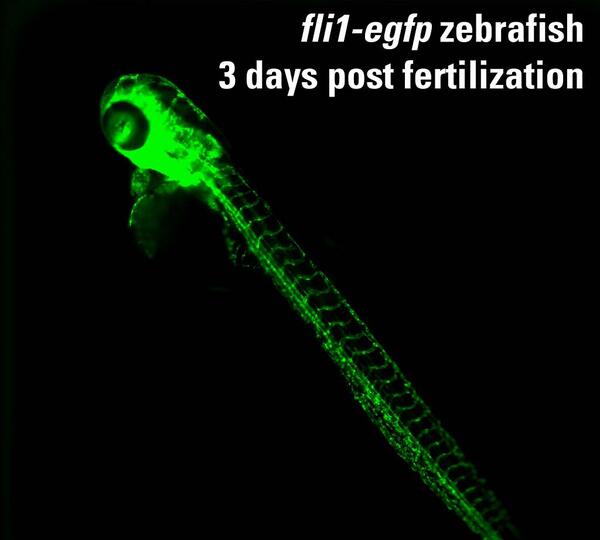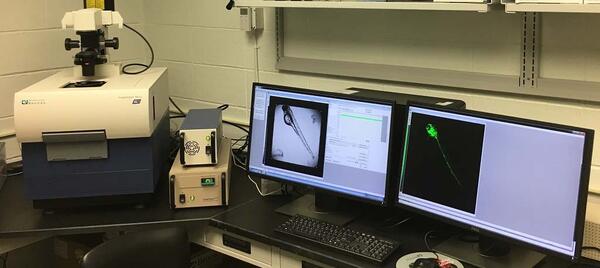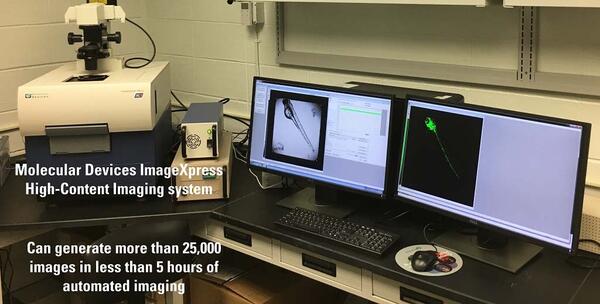Panoramic view of scientists in boat on Hells Canyon Reservoir, Idaho
Images

Panoramic view of scientists in boat on Hells Canyon Reservoir, Idaho

Particulate matter captured on a quartz fiber filter at the Mercury Research Laboratory.
Particulate matter captured on a quartz fiber filter at the Mercury Research Laboratory.
Algal bloom near the Ash River boat dock, a public access point for boating and fishing on Kabetogama Lake. Microcystin has been detected at this location and at nearby Sullivan Bay at concentrations exceeding recreational guidelines.
Algal bloom near the Ash River boat dock, a public access point for boating and fishing on Kabetogama Lake. Microcystin has been detected at this location and at nearby Sullivan Bay at concentrations exceeding recreational guidelines.

An algal bloom near the Ash River Visitor Center at Kabetogama Lake, where visitors enjoy picnics and trails year-round.
An algal bloom near the Ash River Visitor Center at Kabetogama Lake, where visitors enjoy picnics and trails year-round.

Eosin-nigrosin staining of spermatozoa from common carp (Cyprinus carpio) testes collected from the Lake Mead National Recreation Area, Nevada
Eosin-nigrosin staining of spermatozoa from common carp (Cyprinus carpio) testes collected from the Lake Mead National Recreation Area, Nevada

Microscopic video imaging is used for computerized analysis of sperm motility parameters
Microscopic video imaging is used for computerized analysis of sperm motility parameters

Tablet-enabled field forms have been developed to help coordinate field efforts, collect site information, GPS coordinates, photos, and control data collection.
Tablet-enabled field forms have been developed to help coordinate field efforts, collect site information, GPS coordinates, photos, and control data collection.

A USGS scientist prepares a sample to test the effect of antibiotics on denitrifying bacteria within a glove box. A glove box allows scientists to work with samples in an anaerobic (no oxygen) atmosphere, the conditions under which denitrification occurs.
A USGS scientist prepares a sample to test the effect of antibiotics on denitrifying bacteria within a glove box. A glove box allows scientists to work with samples in an anaerobic (no oxygen) atmosphere, the conditions under which denitrification occurs.

Using the 384-well plate format, a single zebrafish embryo is tested in each well. This is an example of a 72 hour post fertilization fli1:egfp zebrafish (3 millimeters long) imaged under a fluorescein isothiocyanate (FITC) filter.
Using the 384-well plate format, a single zebrafish embryo is tested in each well. This is an example of a 72 hour post fertilization fli1:egfp zebrafish (3 millimeters long) imaged under a fluorescein isothiocyanate (FITC) filter.

Molecular Devices ImageXpress† High-Content Imaging System
Molecular Devices ImageXpress† High-Content Imaging System

Molecular Devices ImageXpress† High-Content Imaging System that can generate more than 25,000 images in less than 5 hours of automated image acquisition.
Molecular Devices ImageXpress† High-Content Imaging System that can generate more than 25,000 images in less than 5 hours of automated image acquisition.

U.S. Geological Survey (USGS) scientist working on data analysis of cyanotoxins in water samples
U.S. Geological Survey (USGS) scientist working on data analysis of cyanotoxins in water samples

Keith A. Loftin, USGS, is the lead scientist for algal and cyanobacterial toxins
Keith A. Loftin, USGS, is the lead scientist for algal and cyanobacterial toxins
USGS scientists evaluating the nebulizer assembly in a mixed mode ionization source of a triple quadrupole mass spectrometer used to measure individual cyanotoxins
USGS scientists evaluating the nebulizer assembly in a mixed mode ionization source of a triple quadrupole mass spectrometer used to measure individual cyanotoxins

Native birds resting on marker buoys in Brownlee Reservoir, Idaho.
Native birds resting on marker buoys in Brownlee Reservoir, Idaho.

Draining overlying water from sedimentation sampler at Brownlee Reservoir, Idaho.
Draining overlying water from sedimentation sampler at Brownlee Reservoir, Idaho.

Between 2009 and 2018, scientists conducted a national scale assessment of mercury accumulation in the National Park System using dragonfly larvae as biosentinels (species that accumulate a pollutant in their tissues as an index of exposure to other organisms without significant adverse effects to the biosentinel) through a citizen science network called the Dragonf
Between 2009 and 2018, scientists conducted a national scale assessment of mercury accumulation in the National Park System using dragonfly larvae as biosentinels (species that accumulate a pollutant in their tissues as an index of exposure to other organisms without significant adverse effects to the biosentinel) through a citizen science network called the Dragonf

Photograph of the entrance to Grand Traverse Bay Harbor, located 8 kilometers downdrift of the spoils pile. Migration of the dark-colored stamp sands (moving from left to right) has buried the original beach, overtopped the wall, and partially blocked the channel.
Photograph of the entrance to Grand Traverse Bay Harbor, located 8 kilometers downdrift of the spoils pile. Migration of the dark-colored stamp sands (moving from left to right) has buried the original beach, overtopped the wall, and partially blocked the channel.

Cover of the 2018 publication, "California’s Fourth Climate Change Assessment: Statewide Summary Report."
Cover of the 2018 publication, "California’s Fourth Climate Change Assessment: Statewide Summary Report."

This image shows citizen scientists along with National Park Service personnel identifying invertebrates as part of the Dragonfly Mercury Project.
This image shows citizen scientists along with National Park Service personnel identifying invertebrates as part of the Dragonfly Mercury Project.
After 100 years of restricted tidal activity to support agricultural use and salt harvesting, the tidal marshes around San Francisco Bay, like this one at Bair Island, are steadily rebuilding, returning to a stunning mosaic of marsh, mudflat, and channels.
After 100 years of restricted tidal activity to support agricultural use and salt harvesting, the tidal marshes around San Francisco Bay, like this one at Bair Island, are steadily rebuilding, returning to a stunning mosaic of marsh, mudflat, and channels.




